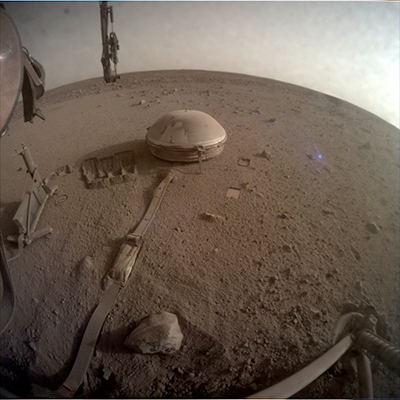|
Author
|
Topic: [Discuss] NASA's InSight mission on Mars
|
Robert Pearlman
Editor Posts: 49699
From: Houston, TX
Registered: Nov 1999
|
 posted 01-21-2020 01:23 PM
posted 01-21-2020 01:23 PM
   
quote:
Originally posted by Headshot:
...it sure looks like Insight's mole has popped back out of Mars again, but not as much as before.
Apparently so. From InSight on Twitter: After making good progress in recent weeks, another day of digging on Mars leads to the mole backing out by a couple of centimeters. My team keeps pushing forward and is exploring several options. |
oly
Member Posts: 1431
From: Perth, Western Australia
Registered: Apr 2015
|
 posted 01-21-2020 05:14 PM
posted 01-21-2020 05:14 PM
   
This must be the most expensive game of Whack-a-Mole ever. |
Robert Pearlman
Editor Posts: 49699
From: Houston, TX
Registered: Nov 1999
|
 posted 01-08-2021 01:03 PM
posted 01-08-2021 01:03 PM
   
NASA has extended the InSight mission for two years, following an external review of its scientific productivity. The InSight mission is extended for two years, running through December 2022. InSight's spacecraft and team deployed and operated its highly sensitive seismometer to expand our understanding of Mars' crust and mantle. Searching for and identifying Marsquakes, the mission team collected data clearly demonstrating the robust tectonic activity of the Red Planet, and enhanced our knowledge of the planet's atmospheric dynamics, magnetic field, and interior structure. InSight's extended mission will focus on producing a long-duration, high quality seismic dataset. Continued operation of its weather station and burial of the seismic tether using the spacecraft's Instrument Deployment Arm (IDA), will contribute to the quality of this seismic dataset. The extended mission may continue deployment (at low priority) of the spacecraft's Heat Probe and Physical Properties instrument (HP3), which remains close to the surface. |
Fra Mauro
Member Posts: 1739
From: Bethpage, N.Y.
Registered: Jul 2002
|
 posted 01-09-2021 11:46 AM
posted 01-09-2021 11:46 AM
   
It’s always great to see these unmanned probes exceed expectations and their design life. Best value for the taxpayer dollar! |
Robert Pearlman
Editor Posts: 49699
From: Houston, TX
Registered: Nov 1999
|
 posted 01-14-2021 11:14 AM
posted 01-14-2021 11:14 AM
   
NASA will no longer attempt to embed the heat probe in the Martian soil. From InSight on Twitter: Last weekend, the mole made a final attempt to dig farther underground on Mars. Even with all the steps we've taken to #SaveTheMole, it seems there's just not enough friction in this soil to keep it moving downward. The soil here is different than anything else we've dealt with on Mars: It clumps together in a way no other mission has experienced. The mole was designed to work in soil that flows freely around it. So the end has come for one part of my mission. For my team, it's a tough decision. For over a year and a half, we've done all we can to solve this unique challenge. What we've learned, we’ll carry forward to future missions, and to my next task. In my extended mission, I'll spend the next two years listening for more marsquakes. To help get the clearest signal, I'm going to bury the cable that runs between me and the seismometer. More science to come. Onward. |
Headshot
Member Posts: 1153
From: Vancouver, WA, USA
Registered: Feb 2012
|
 posted 02-27-2021 01:01 PM
posted 02-27-2021 01:01 PM
   
Has anyone heard if Insight's seismometer recorded any impacts generated by Perseverance's landing? Besides impacts from the two tungsten balance weights, there are of course, impacts from the heat shield, back shell, descent stage, and the rover itself. |
Robert Pearlman
Editor Posts: 49699
From: Houston, TX
Registered: Nov 1999
|
 posted 02-27-2021 01:10 PM
posted 02-27-2021 01:10 PM
   
The InSight team released this update: InSight acquired high-resolution data from its seismometer, pressure sensor, and wind sensor during the time interval bracketing Perseverance's entry, descent and landing in an attempt to detect seismic or atmospheric signatures of the rover's landing process. The data is both complex and intriguing. We are continuing to analyze the data, and anticipate that the process of interpretation will take some time. |
SpaceAholic
Member Posts: 5190
From: Sierra Vista, Arizona
Registered: Nov 1999
|
 posted 07-22-2021 03:35 PM
posted 07-22-2021 03:35 PM
   
NASA-funded researchers said Thursday (July 22) they had mapped the interior of Mars, using seismic data collected by the agency’s Mars InSight lander to reveal a planet with a molten core whose size and composition came as major surprises. The interior map — the first ever created of another planet — shows that the internal structure of Mars differs dramatically from Earth's. Mars has a thicker crust and a thinner underlying mantle layer as well as a core that is bigger, less dense and more liquid than the researchers had expected.The scientists said their findings, which were described in three papers published Thursday in the journal Science, suggest that Mars formed millions of years before Earth, when the sun was still condensing from a cloud of glowing gas. |
SpaceAholic
Member Posts: 5190
From: Sierra Vista, Arizona
Registered: Nov 1999
|
 posted 12-19-2022 09:28 PM
posted 12-19-2022 09:28 PM
   
From NASA Insight (via Twitter): My power's really low, so this may be the last image I can send. Don't worry about me though: my time here has been both productive and serene. If I can keep talking to my mission team, I will – but I'll be signing off here soon. Thanks for staying with me.  |












